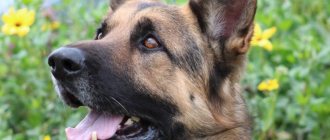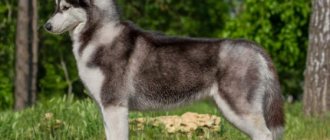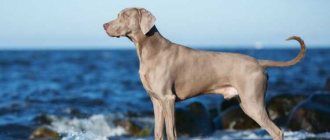| Intelligence: |
| Aggressiveness: |
| For security: |
| For children: |
| Training: |
| Difficulty in care: |
The Croatian Shepherd is a very agile, energetic medium-sized dog that has long been considered the best shepherd of flocks of sheep and horses. Representatives of this breed are very attentive and friendly towards people and other animals. Therefore, such a dog will be an excellent option when choosing a companion.
History of this breed
Based on the name, it is easy to guess that this breed originates from the distant country of Croatia, namely from Slavonia, which is located in the east. Presumably, related breeds are the Hungarian water dog, as well as the more popular in our time, the Puli dog.
The first document describing representatives of this breed was dated 1374, based on information from which the Croats, who occupied their territories in the 7th century, already had these dogs. Officially, this breed was recognized only in 1968, and the first standard was in 1969. If you believe the opinion of experienced shepherds, these dogs perfectly remember the nicknames of their “wards” and distinguish them from each other.
Historical reference
Outside their homeland, four-legged animals are practically unknown, but in Croatia, the breed lives and does not lose its popularity for more than half a century. Experienced livestock owners prefer to work only with Croatian Shepherds, since the abilities of this breed are ideal for working as a shepherd.
In origin, the Croatian Shepherd is more of an indigenous breed than a deliberately bred breed. It is known that during their formation, bloodlines were subject to selection, but these episodes are insignificant against the backdrop of the skills that dogs acquired naturally. Only in recent years has selection in its true meaning become relevant and the only reason for this is the growing popularity of Croatians in show work.
This is probably the only dog whose first and clear description of the breed dates back to the 9th century. The old notes were discovered by a veterinarian. In a pile of securities, a description of a dog was found that was ideal for herding and guarding livestock. The description of the shepherd dog of those times fully corresponds to the modern breed standard, which indicates a very strong blood heredity. The first discovery was made in the mid-19th century and was followed by a second - another document describing a "local" herding dog of keen intelligence and good health, which, you guessed it, also fully corresponds to the modern standard of Croatian Shepherd Dogs.
The veterinarian, S. Romić, who was lucky enough to find both documents, lived in the eastern part of Croatia and became the first interested breeder of the breed. Breeding work began in 1935. It took the man 34 years to find allies in his cause and achieve recognition for his charges. Today, the Croatian Shepherd, although considered a very rare breed, is officially recognized by the Fédération Cynologique Internationale (FCI).
Breed standard
The current standard has been in force since 1996. According to him, the color of these dogs is black, sometimes with white markings on their paws. The coat is quite long, soft and curly, especially in the back area. The height of dogs at the withers is allowed from 40 to 50 cm .
The tail of the animal in a calm state is lowered, and in an excited state it rises 7-10 cm above the line of the back and has thick hair. Now, it is often docked, leaving 4 cm in length.
The hind legs are straight, parallel, and have strong, muscular thighs. The hock joints are well developed. The paws are small in size, somewhat elongated in length.
The ears are triangular in shape and pointed towards the top, widely spaced.
The head is small (about 20 cm in length) and wedge-shaped. The nose is black. The brow ridges are poorly developed. The eyes are medium-sized, almond-shaped and can be black, brown or amber in color.
Character
Dogs of this breed are particularly cheerful , energetic and agile. They have a wonderful, flexible character, are very loving and need a trusting relationship with their owners.
Croatian Shepherds are a herding breed, so they have long been accustomed to communicating not only with people, but also with other animals. Of course, in our time, due to the much smaller number of herds, such dogs are also used as guard dogs, the functions of which they cope well with.
Due to their breed characteristics, these dogs need constant physical activity, which has a beneficial effect on their health and psycho-emotional state. They respond well to training, and in the absence of training, they can become aggressive and less disciplined. At the same time, these dogs become very attached to their only owner, and get used to strangers very poorly, being afraid and not trusting them. If necessary, they can rush to protect their owners, and even bite, but they do this extremely rarely.
Puppies of this breed can be allowed to work as early as 3-4 months of age, without fear that the number of responsibilities is beyond their strength. They, on the contrary, show themselves to be smart, responsible guards and shepherds.
Representatives of this breed can become wonderful “nannies” in large families, since they simply do not know how to show aggression towards children and carefully protect them from any dangers.
Temperament[edit]
| This article contains terms of endearment: vague language that often accompanies biased or unverifiable information . |
Adult Croatian Shepherd
The Croatian Shepherd is an attentive, active, insightful and intelligent dog with great energy and a strong need for human interaction. It's healthy, disease resistant and inexpensive to maintain. It has a well-developed herding instinct and is an excellent watchdog.[1]
This is a caring and modest herding dog, very loyal to its owner. The breed also has a hereditary predisposition to working as draft animals. Some farmers claim that their Croatian Shepherd knows and identifies each head of cattle when hearing its name.
In the past, this dog was often used to herd herds of pigs into the oak forest in the fall, and one old document states that this versatile breed even herded horses from the Lakovo stables. It is both a sled dog and a gathering dog, and depending on whether it comes from a show or work environment, its desire to work with animals varies. Its approach to the herd may be closer and more difficult than some other breeds, but it is very effective. It can grab, but this rarely causes any damage. However, this requires firm but sensitive handling, and these aggressive tendencies can be easily overcome with training. The breed is very intense and can bark a lot in the early stages of training, but with experience it usually only barks at the right times - mainly when working in the yard. This dog usually only obeys one person, and it may take a while for an older Shepherd to switch over to a new owner. If not socialized early, he may be wary of strangers. The Croatian Shepherd responds well to obedience training, but as a pet without any work it can become very noisy and even destructive. However, this is a very obedient breed and quickly understands what is expected of it, which it does with pleasure. At about 3 or 4 months, the puppy is usually introduced to the herd. In most cases, these puppies work alongside the older dog and the puppy learns its job and is useful for work at about 6 months. a very obedient breed and quickly understands what is expected of it, which it does with pleasure. At about 3 or 4 months, the puppy is usually introduced to the herd. In most cases, these puppies work alongside the older dog and the puppy learns its job and is useful for work at about 6 months. a very obedient breed and quickly understands what is expected of it, which it does with pleasure. At about 3 or 4 months, the puppy is usually introduced to the herd. In most cases, these puppies work alongside the older dog and the puppy learns its job and is useful for work at about 6 months.
He is always at his owner's heels, waiting for the next move and often looks into his owner's eyes asking, "What's next?" Nowadays, fewer and fewer Croatian Shepherds make their living working livestock in their native Slavonia, because many open plains are used for crops and livestock are kept indoors. Croatian Shepherds do well in an apartment as long as they get enough regular exercise.
Conditions for keeping a Croatian Shepherd
Dogs of this breed cannot be called too whimsical, so difficulties in their maintenance practically never arise.
Since shepherd dogs have long hair with a well-developed undercoat, it is better to keep them outside, in the private sector. An enclosure intended for a dog should be moderately warm and protected from drafts. You should not make the floors of the enclosure concrete; it is better to make them wooden, strewn with sawdust. This will help avoid many health problems and will make cleaning the enclosure much easier.
Such a dog should be bathed no more than 2-3 times a year, using special detergents, since long hair tends to get tangled often. In hot, dry seasons, light wetting of the wool is allowed to prevent overheating of the body.
Walks of the Croatian Shepherd should be long, at least 2 times a day, full of physical activity and training.
Literature
- Your dog is a bodyguard, E.N. Mychko, V.A. Belenky. Aquarium; Moscow; 2003
- History of the development of service dog breeding in Russia, Krasnoperova E.A. and others. Materials of the All-Russian scientific and practical conference. 2019
- Domestic breeds of service dogs. N. G. Andrianova and others St. Petersburg. MP "Publisher" 1992, - 288 p., ill.
- Dogs in medicine, Nikolaeva, E.V. Collection of materials from the scientific and practical conference within the framework of the VII International Scientific and Sports Festival of Cadets and Students. In 2 volumes. Compiled by V.A. Ovchenkov. 2022. Publisher: Perm Institute of the Federal Penitentiary Service (Perm)
- South Russian Shepherd Dog. Mishchikha O. Friend: magazine. - 2004. - No. 10. - P. 44-53.
- South Russian Shepherd Dog. Tsigelnitsky E. Friend: magazine. - 2003. - No. 3. - P. 6-15.
- South Russian Shepherd Dog. Falcon A. My friend the dog: magazine. - M.: Animal Press, 2012. - No. 6. - P. 33.
Nutrition
Of course, the best solution for keeping such dogs is a balanced premium food that includes the necessary vitamins and minerals. If this is not possible, it is necessary to include in the dog’s diet lean meat, cereals (rice, wheat; it is better to exclude buckwheat), fresh vegetables and dairy products.
You should not combine feeding your dog natural food with food, since this significantly increases the load on the digestive organs and more often leads to obesity.
Photo of Croatian Shepherd
Cost and nicknames
Among the common nicknames for these dogs are Athos, Jersey, Bim, Laura.
You should only purchase puppies from vetted breeding clubs or from professional breeders with the appropriate documents and a veterinarian’s report on the dog’s health, since this is the only way to avoid deception.
The price of a Croatian Shepherd puppy ranges from $1,000 to $1,300 . Despite such a high price, you simply cannot find a better friend and protector for yourself and your family members.
How much does a shorthaired pointer cost?
Since time immemorial, the shorthaired pointer has been one of the most expensive breeds, largely due to its excellent hunter instincts. Now prices are more affordable. A pet-class dog will cost the future owner 15,000 - 25,000 rubles. For a breeding shorthaired pointer you will have to pay from 30,000 to 40,000 rubles. As for exhibition pieces, the price has no limits. The lower limit starts at 60,000 rubles and above. Think about what you expect from your future pet - and act! In any case, the acquired shorthaired pointer will become your best and most loyal friend.
—











